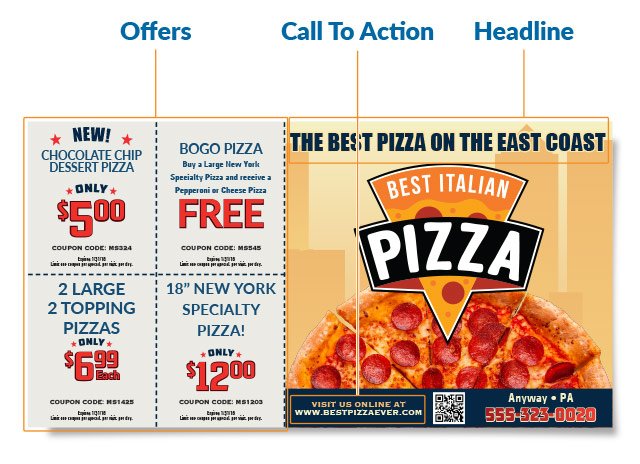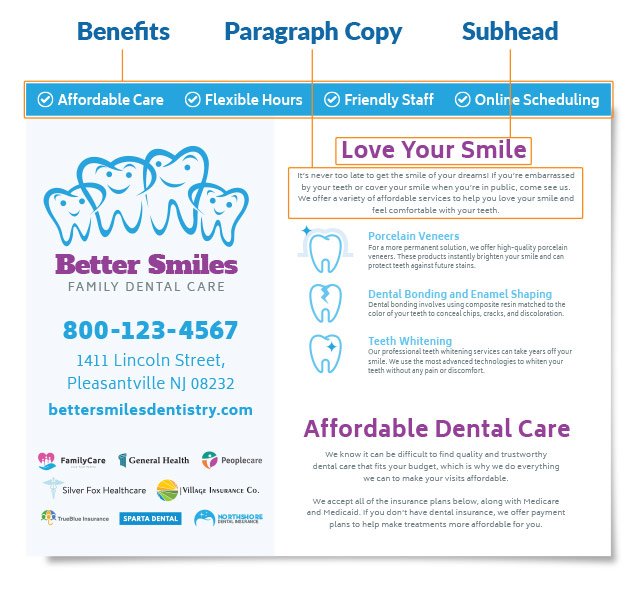
How to Write Direct Mail Copy That Sells
One of the most important aspects of any direct mail piece is the copy, or the words on your advertisement. Well-written copy engages readers and tells them what they need to know about your product or service. Even when paired with eye-catching images and beautiful fonts, mediocre writing can’t beat skillfully written copy.
Whether you’re looking to improve your existing direct mail copy or just venturing into copywriting for the first time, we’re here to help. This guide will cover the main copy elements you’ll find on most mail pieces and provides helpful tips to write direct mail ad copy that sells. Let’s dig in.
Learn About Your Audience
Knowing your audience’s wants and needs helps you create compelling copy that inspires them to act. One of the best ways to learn about your audience is through market research, which is the process of gathering data on consumer preferences. Here are a few tips on how to do your own research.
Analyze your in-house customer list. Look for common traits and patterns among existing customers. Do a large cluster of them live in a certain area? Are there recurring trends in their buying behaviors?
Consult with your frontline employees. Staff members who deal directly with customers and leads should be able to provide insight into their most common needs and complaints. This knowledge helps you tailor your marketing message to address those pain points directly.
Conduct surveys. Mail, email, or call current customers for feedback on whether you’re meeting their needs and expectations. You can also speak directly with prospects when they visit your location.
Once you know what audiences are looking for, you can emphasize those aspects of your product or service in your ad copy.
Consider Your Direct Mail Format
Before you dive into the writing, the next step is to figure out which direct mail format you’re going to use. Types of direct mail formats include postcards, envelope mailers, brochures, catalogs, circulars, etc. The format you choose dictates the amount of copy you can fit on the piece and the copy elements you’ll include.
For example, if you choose a postcard, you’ll need to keep your message brief with a simple headline, benefits, an offer, and a call to action. On the other hand, if you choose a brochure, flyer, or sales letter, you’ll have more room for additional copy elements like subheadings and paragraph copy. Ultimately, with the exception of sales letters (some of which can be over 50 pages), the general rule is to always keep copy short and to the point.
Here are a few visual examples of popular direct mail formats and their copy elements:


For more information on direct mail formats and when to use them, check out our article, What Is Direct Mail Marketing?.
Now that you’ve done your homework, you’re ready to jump into actually writing your pieces.
Write Gripping Headlines & Subheads
The first must-have copy elements of any direct mail piece are headlines and subheads. In fact, marketing pioneer David Ogilvy’s 1963 claim that 5 times as many people read headlines as they do body copy still rings true today.
Your goal should always be to tell a story with your headings, since they’re the best way to pull prospects through your piece. Your audience should be able to read your headline and subheads and walk away with an understanding of what your piece is about without reading anything else.
Tips for Creating Direct Mail Headlines & Subheads
Be concise. If you want your audience to make it through your piece, keep headlines and subheads as short as possible. The maximum length most readers can comprehend at a glance is 8 words, so that’s a good rule of thumb to follow, regardless of format. On the other hand, your subheads can be a bit longer than your headlines.
Include benefits in your headings. The best headlines often include your best benefit. This helps you catch your audience’s attention and lets them know what you have to offer right up front. You can then use your subheadings to further explain the benefits of your product or service.
Ask your audience a question. A great way to create engaging headlines and subheads is to ask prospects a question. This demonstrates empathy and proves you understand their pain points.
Direct Mail Headline & Subhead Examples
- Affordable Dental Care We Accept Most Major Insurances
- Want to Look Great This Summer? Join Ginny’s Gym for Only $1 Down & $10 a Month!
Clearly Explain Your Benefits
Explaining the benefits of your product or service to prospects is also key to writing effective direct mail copy. To start, you need to know the difference between a feature and a benefit. A feature is a particular aspect of your product or service that provides a benefit to customers. On the other hand, a benefit is the result of the product or service having that particular feature.
For example, a feature of an oven might be its pre-programmed recipe settings. The benefit of those settings is the ability to program unique cooking times and temperatures for individual dishes. In this case, you might write “Perfectly cook every dish automatically!” to express how this feature benefits prospects. Always emphasize the benefits your product or service in terms of how it will improve your prospects’ lives.
Tips for Explaining the Benefits of Your Product or Service
Place the benefit at the start of the sentence. For example, say “Save valuable time with our all-in-one vacuum cleaner,” instead of “This all-in-one vacuum cleaner saves you valuable time.”
Invoke their feelings. Purchases are usually emotional decisions rather than logical ones. Explain your benefits in language that speaks to your readers’ feelings and how your product or service will make their lives better.
Don’t use industry lingo or jargon. Avoid using confusing terms that only industry experts would understand so you don’t alienate prospects. If you’re writing to a more informed audience, though, you can get more technical with your language.
Direct Mail Benefit Statement Examples
- Feel your best!
- You’ll save hundreds!
- Love the way you look!
- Make more money!
Keep Paragraph Copy Short
While most direct mail pieces won’t require lots of paragraph copy, some (like sales letters or large brochures) do. This text should be concise, yet long enough to make a convincing case for why prospects need your product or service. Again, put yourself in your audience’s shoes when you’re writing, and remember that they want to know what’s in it for them.
Tips for Writing Paragraph Copy
Give each idea its own paragraph. Talking about multiple ideas in the same paragraph can confuse readers. Keep your messaging consistent and impactful by making sure every sentence in your paragraph supports the same main point.
Keep paragraphs short. In general, your paragraphs should be no longer than 2-3 sentences. Large blocks of text are overwhelming, and the general rule is that white space should make up almost half of your piece.
Tell your product or service’s story. In some cases, your product or service may have an interesting backstory. Tell readers about it in your paragraph copy to grab their attention and get them interested.
Include an Irresistible Offer
Perhaps the most important piece of copy for any direct mail piece is your offer. Simply put, your offer spells out what prospects will receive if they take action. Ultimately, your offer must be so valuable and enticing to audiences that they can’t possibly turn it down.
Tips for Creating Direct Mail Offers
Use engaging words. Keep things interesting by using words like “free.” This gets prospects excited about the great deal you’re giving them.
Make it time sensitive. It’s important to create a sense of urgency with your offer. If you don’t motivate prospects to act right away, they won’t be in a hurry to take advantage of it. Examples of time-sensitive offers include “Offer good through [date],” “limited time only,” and “while supplies last.”
Make it risk-free. Make your prospects feel comfortable by creating a risk-free offer and letting them know what the next steps in the process are. Always be transparent with them and make sure they know what to expect. Examples of risk-free offers include money back guarantees or the ability to return a product if the customer isn’t satisfied.
Direct Mail Offer Examples
- $19.99 Oil Change
- Free Consultation
- $10 Off Hair Color & Highlights
- Free Appetizer with Purchase of Any Entree
Make the CTA Obvious
A direct mail call to action (CTA) is a sentence or phrase designed to tell prospects what they need to do next, such as call, go online, or visit a store. Ultimately, your CTA tells people how to claim your offer and moves them through the sales funnel.
Tips for Creating Direct Mail CTAs
Make taking action seem easy. Always write CTAs that make taking the action you’re requesting seem effortless. One case study showed using an effortless word like “get” as opposed to an effort word like “order” increased conversions by 68%. This is because asking someone to “order” implies they need to make an effort to take advantage of your offer, rather than just receiving it.
Stick to one CTA per piece. While you can reiterate your CTA multiple times on your direct mail piece, don’t include several different CTAs. One clear call to action with specific direction makes it easy for prospects to understand what to do next. Plus, it increases the likelihood they’ll take the specific action you want them to.
Be clear. Your CTA should be precise and easy to understand. Try to use as few words as possible and be specific about what you want prospects to do.
Direct Mail CTA Examples
- Visit Our Website
- Call Today
- Shop In Store
- Schedule Now
Conclusion
Writing convincing and powerful marketing copy is crucial to the success of your direct mail campaign. Copy tells prospects what they need to know to take advantage of your offer and how they’ll benefit from doing so.
The first step in writing great copy is knowing your audience’s pain points and how you’ll alleviate those problems. You also have to choose the right format for your mail piece. It should be long enough to tell prospects the essentials without being too wordy. Then, you’ll craft your pieces using copy elements like headlines, subheads, benefits statements, paragraph copy, offers, and CTAs.
Follow these steps, and you’ll be able to craft effective direct mail pieces that get prospects’ attention and spur them to take action.